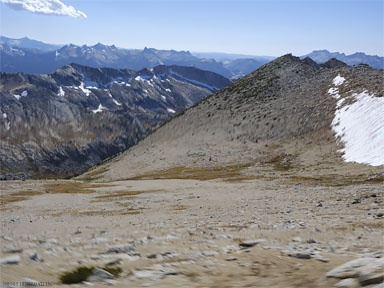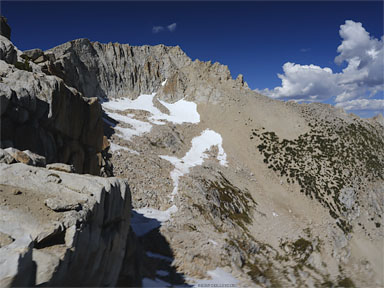Fujifilm GFX100 II: Terrible Blur with Image Stabilization (IBIS) at Relatively High Shutter Speeds
UPDATE: see reader comments on this issue.
...
I’m loving the EVF of the Fujifilm GFX100 II—it’s such a huge upgrade, as is its improved responsiveness in most areas of operation (along with some curious stagger/stutter behavior in menus). But the GFX100 II has all the problems and bugs of the Fujifilm GFX100S—Fujifilm has made zero progress on resolving many longstanding issues.
Basically, you get a nicer camera but with the same ol' problems and bugs.
Blurred IBIS
Here’s a real confounder, which I noted last month with the GFX100S: differential bizarre blur when IBIS is in use. This destroyed more than a few handheld panoramas that I shot—maybe I have to give up on handheld, since IBIS is failing badly far too often. So much for “8 stops compensation”.
Fujifilm GFX100S: Severe Blurring from IBIS, Partial Frame
I’ll put the quality of my handheld shooting technique up against anyone’s. I consider myself an expert on the matter...! Maybe there is some type of movement the IBIS just cannot handle well? Maybe it is an interaction with the electronic shutter eg sensor readout transit time plus IBIS? Would electronic first curtain shutter work better? I don’t know, but if that were the case the user manual is silent on it. I have not had to even consider such things with Sony or Nikon or other brands.
I thought I had a tool I could rely upon.
Is it bad IBIS or just some obtuse limitation? I have never seen such bizarre sharp-blurred-sharp behavior before on any camera’s IBIS. I can show you a dozen such failures from a single day—probably more, but I have not had time to assess the damage.
Thing is, if it’s a handheld panorama, the entire panorama is toast with just one failure*—and there is no easy way to check for issues, since the sharpness can be good in one area of the frame but not another—try checking just 3 or 4 images to be sure—that’s a lot of scrolling-around with just one of the images.
The loss of images that are exceedingly difficult to redo* (irreplaceable actually) is disturbing.
* NJust redo a grueling and somewhat intimidating 10.2 mile hike/climb with 3300 feet of elevation gain taking all day. Kinda like reshooting a wedding cuz the camera f*cked up. Isn’t this a pro camera? And why in bloody hell can’t the camera WARN the user if there is uncorrectable blur, if only by doing image analysis post-shot... this is 2023 not 2013. We should have a shit-ton of computational photography helping us out, not silent failures. OMG.
From the EXIF:
Image Stabilization : Sensor-shift; On (mode 1, continuous); 0
Roll Angle : 1.2
Christopher K writes:
The issue you described today, a blurry section of an image, comes from the electronic shutter: you moved the camera accidentally sidewards before the electronic shutter scanned the whole sensor height. It has nothing to do with IBIS.
DIGLLOYD: of course there was camera movement; that’s the whole point of having IBIS compensate. But if the shutter had been EFC (electronic first curtain) or full mechanical, the same movement would have occurred.
Does IBIS work with electronic shutter (ES) or not? And if it does not, why doesn’t the user manual say so.
Does IBIS not work with ES but somehow work with EFC? Consider the same movement for both ES and EFC: IBIS would have to compensate as the movement occurred. The only difference is that with EFC, the shutter closes after the entire exposure time has elapsed.
With ES, the image is being scanned in approximately 20 bands from top to bottom (assuming about twice the speed of the GFX100S). Some of the examples clearly show that areas are sharp and some are not (in alternation), thus it appears that IBIS must be working on each band as it scans, or so it seems to me.
If the claim here is that IBIS does not work with ES, then why does it work with Sony and Nikon, or rather I should say: I’ve never seen such an issue with Sony and Nikon. However, their sensor readout transit times are ~5X faster.

Fujifilm GFX100 II + Fujifilm GF 35-70mm f/4.5-5.6 WR @ 42.6mm equiv (51.8mm) + polarizer Breakthrough Photography X4
ENV: Mt Conness, altitude 12200 ft / 3719 m, 60°F / 15°C
RAW: vignetting corrected
[low-res image for bot]

Fujifilm GFX100 II + Fujifilm GF 35-70mm f/4.5-5.6 WR @ 57.6mm equiv (70mm) + polarizer Breakthrough Photography X4
ENV: Mt Conness, altitude 12200 ft / 3719 m, 60°F / 15°C
RAW: vignetting corrected
[low-res image for bot]

Fujifilm GFX100 II + Fujifilm GF 35-70mm f/4.5-5.6 WR @ 28.8mm equiv (35mm) + polarizer Breakthrough Photography X4
ENV: Mt Conness, altitude 11600 ft / 3536 m, 60°F / 15°C
RAW: vignetting corrected
[low-res image for bot]























